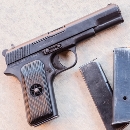
Originally Posted by
JCN

Awesome! That jives with what my ballpark estimates were.
From the article they measured the densities:
Clear Ballistics 10% synthetic gelatin had a density measurement of 790 kg/m³ while 10% porcine gelatin has a density of 1034 kg/m³. Based on density alone, it is conceivable that differences in terminal performance may be noticed when shooting Clear Ballistics 10% synthetic gelatin and 10% nominal porcine gelatin.
And modeled a ~0.8 correction factor.
So my baseline thoughts of adding 20% synthetic gel to a 10% block to get a 13-15% concentration should put the density of the synthetic closer to the organic.
Then we can start to tease out if it’s just a density issue or truly limited by the molecule properties.
It would be one thing if the only thing sold was a 10% block. Then we would be stuck trying to come up with a correction factor.
But they sell 20% blocks that aren’t much more money. And feasibly, you could petition the company to sell a 15% block if that wound up being closer in density and performance to 10% organic.



 Reply With Quote
Reply With Quote



